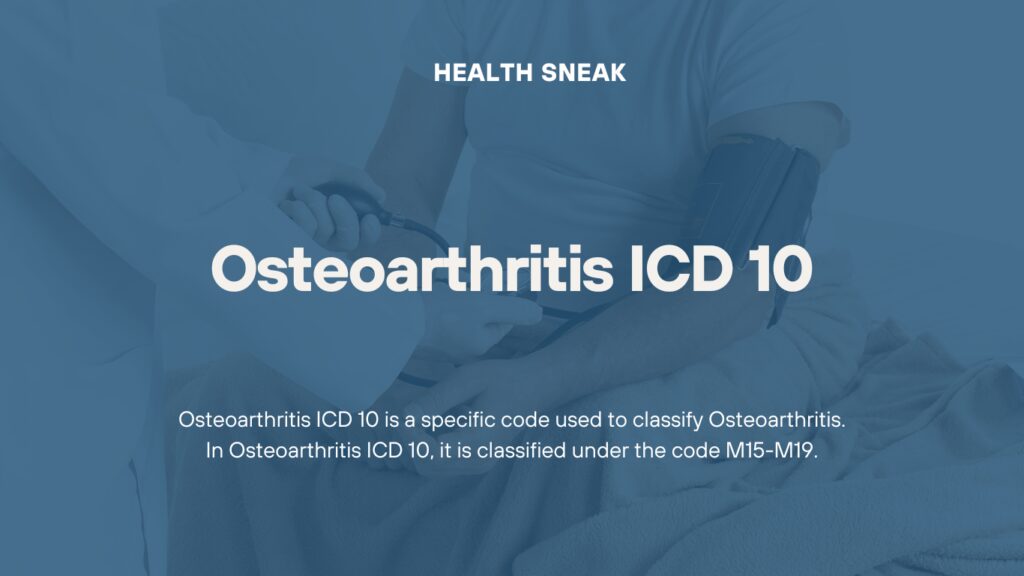ICD is a coding system used to classify diseases and medical conditions, including Osteoarthritis. In this article, we will delve deep into Osteoarthritis ICD 10, its definition, codes, symptoms, and treatment options.

Osteoarthritis is a degenerative joint disorder that affects millions of people worldwide, causing pain, stiffness, and limited mobility. To help healthcare professionals and medical coders classify this condition accurately, the World Health Organization (WHO) developed a system called International Classification of Diseases (ICD).
So, let’s get started!
What is Osteoarthritis ICD 10?
Osteoarthritis ICD 10, which stands for International Classification of Diseases, 10th Revision, is a diagnostic coding system developed by the WHO. It is used to classify and code all medical diagnoses and procedures.
Osteoarthritis ICD 10 is a specific code used to classify Osteoarthritis. In Osteoarthritis ICD 10, it is classified under the code M15-M19.
Osteoarthritis ICD-10 codes are used by healthcare providers to accurately document and communicate diagnoses and treatments to insurance companies, researchers, and other healthcare professionals. The Osteoarthritis ICD-10 system includes codes for all diseases and conditions, including osteoarthritis.
The osteoarthritis ICD 10 code for osteoarthritis is M15-M19, with each subcategory representing a different joint affected. M15 represents polyosteoarthritis, which affects multiple joints. M16 represents osteoarthritis of the hip, M17 represents osteoarthritis of the knee, and M18 represents osteoarthritis of the first carpometacarpal joint (thumb joint). Finally, M19 represents other specified osteoarthritis, which includes osteoarthritis of joints not covered by the other subcategories.
Osteoarthritis ICD 10 codes are important for accurate diagnosis and documentation of the disease. This information is used by healthcare providers to monitor disease progression and provide appropriate treatment options for their patients.
Additionally, insurance companies and other healthcare organizations use osteoarthritis ICD 10 codes to track the incidence and prevalence of in the population. This information can help identify trends and allocate resources to better manage the disease.
In summary, the osteoarthritis ICD 10 code is M15-M19, with each subcategory representing a different joint affected. Accurate diagnosis and documentation of osteoarthritis using these codes are crucial for providing appropriate treatment and managing the disease effectively.
Osteoarthritis ICD 10 Codes
There are several Osteoarthritis ICD 10 codes used to classify, depending on the affected joint and the severity of the condition. Here are some of the common codes used for Osteoarthritis:
- M15 – Polyosteoarthritis
- M16 – Osteoarthritis of hip
- M17 – Osteoarthritis of knee
- M18 – Osteoarthritis of first carpometacarpal joint
- M19 – Other and unspecified Osteoarthritis
It’s important to note that the ICD 10 codes for Osteoarthritis do not specify the cause of the condition. Instead, they focus on the location and severity of the joint damage.
Osteoarthritis and Rheumatoid Arthritis
Osteoarthritis and Rheumatoid Arthritis are two common types of arthritis that are classified using the Osteoarthritis ICD 10 coding system. Osteoarthritis, also known as degenerative joint disease, is caused by the breakdown of joint cartilage, while Rheumatoid Arthritis is an autoimmune disorder that affects the joints.
Both conditions fall under the umbrella term of Rheumatism, which refers to any disease or condition that affects the joints, bones, or muscles. Accurate diagnosis using ICD-10 codes is crucial for effective treatment and management of these conditions.
Diagnosing Osteoarthritis ICD-10
The diagnosis of osteoarthritis is typically made based on a combination of symptoms, physical examination, and imaging studies. The Osteoarthritis ICD-10 code for OA is M17, which includes sub-codes for specific joint locations, such as M17.1 for knee OA and M17.0 for primary generalized OA.
To diagnose Osteoarthritis ICD-10, a healthcare provider will typically perform a physical exam and order imaging studies, such as X-rays or MRIs, to confirm the diagnosis. They will then assign the appropriate Osteoarthritis ICD 10 code to document the diagnosis in the patient’s medical record.
FAQs about Osteoarthritis ICD 10
Can I use the same ICD 10 code for Osteoarthritis for different joints?
No, the ICD 10 codes for Osteoarthritis are specific to the affected joint. For example, the code for Osteoarthritis of the knee (M17) cannot be used for Osteoarthritis of the hip (M16).
Can Osteoarthritis ICD 10 codes be used for other types of arthritis?
No, Osteoarthritis ICD 10 codes are only used to classify Osteoarthritis, which is a distinct type of arthritis. Other types of arthritis, such as Rheumatoid Arthritis or Psoriatic Arthritis, have their own specific codes.
Are there any new codes for Osteoarthritis ICD 10?
The WHO updates the ICD codes periodically, and there may be new codes or changes to the existing codes for Osteoarthritis. It’s important to stay up-to-date with these changes to ensure accurate coding and billing.
Conclusion on Osteoarthritis ICD 10:
Osteoarthritis ICD 10 is an important coding system used to classify and track cases of Osteoarthritis. By understanding the codes, symptoms, and treatment options for Osteoarthritis, healthcare professionals can accurately diagnose and manage this common joint disorder.
If you are experiencing symptoms of Osteoarthritis, it’s important to seek medical attention and work with a healthcare professional to develop a personalized treatment plan. With the right care and management, it’s possible to improve joint function and quality of life for those living with Osteoarthritis.